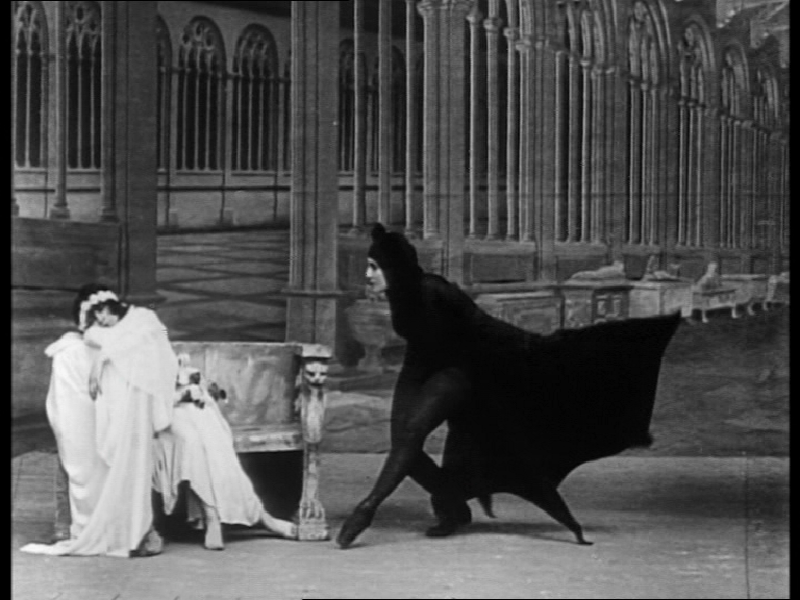The Vampires of Wartime Paris
In the early 20th century, crime and suspense serials were very popular with cinemagoers. They were like the 24 of the silent film era. One of the finest practitioners of the form was Louis Feuillade (1873–1925), a French writer and director of about 700 films. After the success of his Fantômas, Feuillade was encouraged to repeat the trick, so he set about making Les Vampires. It became a classic of its kind, considered by some modern critics as a masterpiece of silent film.
Les Vampires comprises ten episodes with titles that suggest an 18-cert Fawlty Towers: The Severed Head, The Poisoner, The Escaping Dead Man… The action centres on a gang of dangerous criminals known as The Vampires. They aren’t vampires, but some of the film’s style borrowed from Stoker’s great myth (see image below), while a promotional poem made the connection even more explicit. Our hero, Philippe Guerande, is a brave and dogged reporter who chases the Vampires up and down Paris’s eerily empty streets and in and out of its underworld and high society. His reports on the gang have attracted their attention, and before long he’s up to his careful hairdo in mortal danger.

Oscar Mazamette offers goofy support; he’s the film’s comic relief but has moments of heroism too, not to mention shameless hamming and winking at the camera. Most memorable of the Vampires is Irma Vep, the original vamp, described in Time Out as “the notorious anagram”. She’s a dedicated criminal, a master of disguise, and a sort of talisman for the evildoers. Irma Vep is played with great charisma by Jeanne Roques aka Musidora, a former teenage novelist and music hall star. Apparently, when the police banned Les Vampires for glorifying crime, Musidora paid them a visit and had the ban lifted. (Oh, to be a fly on the wall with a time machine.)
Some of the action was improvised based on what was possible in the circumstances of a given day. So the storylines are unpredictable, taking meandering arcs and every so often a wild turn. Although the films are slow compared with, say, Michael Bay’s, viewers are drawn in by their intrigue, strange beauty, and otherworldly ambience. There are deaths, kidnappings and escapes; identities change and disappear; even the architecture shifts and deceives. Les Vampires steadily builds a level of suspense that is maintained impressively over six or seven hours.
Suspense serials like Les Vampires, and movies in general, were a diversion from the horrors of World War I; across the Atlantic, D. W. Griffiths was making history (and controversially revising it) with The Birth of a Nation. But Feuillade’s methods and concerns were a world apart, looking not to the murky past or bloody present but to a perilous and disturbing future. His films anticipated and influenced the French New Wave and the great crime directors like Lang and Hitchcock. They made a deep impression on the surrealists, who appreciated the films’ uncanny imagery, unsettling atmosphere, and flourishes of fantasy, which were all the stronger for being embedded in a largely realist work. Feuillade forged something memorable and unique that continues to entertain and engross almost a century after it was made.
You can watch or download Les Vampires on the Internet Archive.






Great post - this will def be on my download list!
Thanks, Peter! Let us know what you think if you get a chance to watch it.
Cool, will check this out 🙂
Emlyn: Enjoy! Although I watched the serial on a friend’s DVD set, the uploads on the Internet Archive seem fine.
Yes, great post, looks interesting, will have a peek.
Thanks Séamus. If it catches your fancy, you might like Feuillade’s Fantômas too.
Nice one Stan, gonna check the other posts now for some more delights. You must do one on a cracker from 1942 Hellzapoppin’… manic slice of celluloid crazyness…
🙂
Thanks for reminding me about Hellzapoppin’, Iano. I’ve heard it’s a great and truly crazy film — I’ll try to set time aside for it soon.
Nice anemone hairdo, by the way!